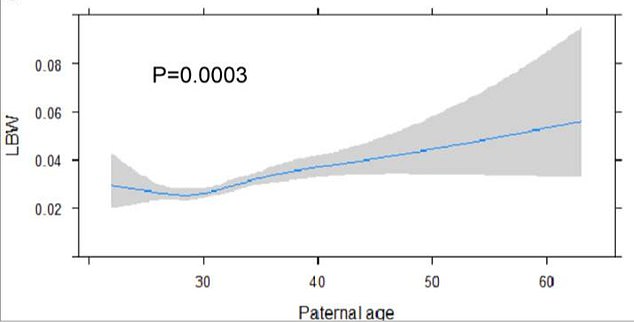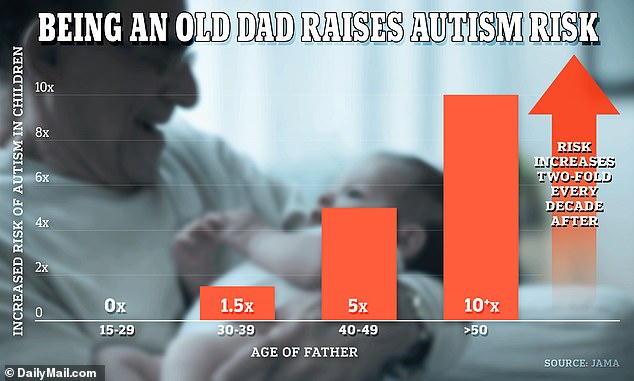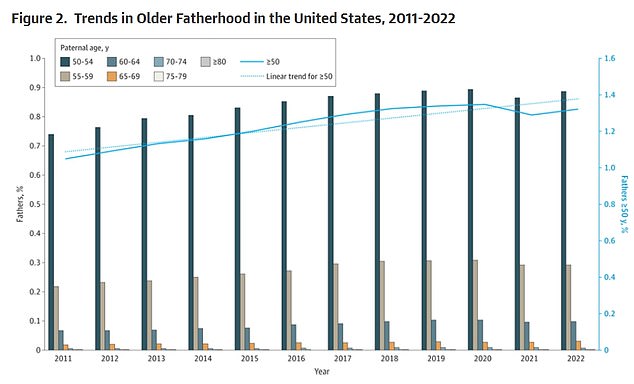The rising proportion of men waiting until their 40s and 50s to have children could be leading to a wave of premature, underweight and unhealthy babies.
The United States has been in the midst of what’s been called a baby boom in recent decades, and the conversation has largely focused on the fact that women are increasingly waiting until they’re too old to give birth, researchers in a new study said.
But men also appear to have a “biological clock” that eventually leads to fertility problems, said the team from Stanford University, Emory University and the University of Rome.
They found a link between fathers in their 40s and 50s and a range of increased birth risks beyond low birth weight and premature birth, including breathing problems, seizures and autism spectrum disorder.
In 2011, fathers aged 50 or older accounted for 1.1 percent of all births in the United States. By 2022, this share had risen to 1.3 percent. The largest increase occurred among fathers aged 50 to 54, whose share of births rose from 0.7 percent in 2011 to 0.9 percent in 2022.

Older paternal age is associated with an increased risk of adverse birth weight outcomes, including low birth weight. Chart courtesy of the journal Frontiers in Endocrinology
The average age of all parents increased steadily from 30.8 in 2011 to 32.1 in 2022, and the share of births in which all parents were 50 years or older increased from 1.1 percent to 1.3 percent between 2011 and 2022, respectively.
Researchers in the United States and Italy analyzed more than 46 million live births in the United States between 2011 and 2022, and paternal age was recorded for 85 percent of them.
Most fathers were under 50, with the average age being around 31. Just over one percent of births were to men aged 50 or older, with the average age in that cohort being 53.8.
The researchers used records of these births to explore the relationship between paternal age and pregnancy outcomes, as well as the effects on maternal health.
Fathers aged 50 to 59 had a 16 percent higher risk of having a baby born prematurely and a 14 percent higher risk of having a baby born with low birth weight, compared with fathers aged 30 to 39.
There was also a 13 percent increased risk that older fatherhood resulted in the mother developing gestational diabetes during pregnancy.
Fathers aged 60 to 70 years also had a higher risk of causing gestational diabetes in the mother, although this risk was not seen in men aged 70 to 75 years.
Meanwhile, 70-year-old men who became fathers were 21 percent more likely to have a baby born prematurely and 24 percent more likely to have a baby born underweight, compared with younger fathers.
They also found that parents over 50 were twice as likely to need help conceiving with assisted reproductive technology (ART) – any type of reproductive treatment or procedure, such as IVF, used to get pregnant.
However, it remains unclear whether this has actually led to an increase in the number of babies born with conditions such as low birth weight, breathing problems, seizures and genetic abnormalities.
The researchers added: “These associations increased with advancing paternal age: fathers aged 70 years or older were more than 6 times more likely to use ART.”
Their findings were published in the journal JAMA Network Open.

The connection between paternal age and autism has been the subject of research for decades, with many large-scale studies involving government health databases and thousands of birth records.
Men’s fertility tends to decline as they age. This is due to a range of factorssuch as a decrease in sperm volume of up to 3.3 percent per year, the inability of sperm to swim, and changes in the structure and shape of sperm.
While women are born with all the eggs they will ever have, men constantly produce new sperm that divide and replicate approximately every 16 days.
Each time those cells divide (which can happen about 800 times by the time a man reaches age 50), they introduce more chances for a genetic mutation to occur.
And a wide range of genetic conditions They have been associated with advanced paternal age, including some skeletal disorders such as achondroplasia, the most common cause of dwarfism.
Advanced paternal age has also been associated with disorders caused by abnormal fusion of one or more joints between the bones of a baby’s skull.
This can lead to an abnormal head shape and increased pressure in the skull, which can harm the baby’s brain development.
In addition to genetic disorders, older fathers have been linked to a higher risk of their children being… diagnosed with schizophreniaobsessive-compulsive disorder, autism spectrum disorder, and bipolar disorder later in life.
A study found that the risk of an older father’s baby being diagnosed with bipolar disorder later in life is 37 percent higher than that of a father in his 30s or 40s.
And an Israeli study showed a more than fivefold increase in the risk of autism for children of men aged 40 or older, compared with those of men under 30.
A very influential person study In 2018, a study by Stanford University compiled data on more than 40 million births and concluded that not only were older fathers more likely to have low birth weight and prematurely born babies, but they were also at higher risk for seizures.

Al Pacino, 83, welcomed his fourth child at the age of 83 with his 29-year-old girlfriend.

Last year, Robert De Niro welcomed his seventh child at the age of 79 with his partner Tiffany Chen.
Compared with fathers ages 25 to 34, which is the average age of fatherhood in the U.S., babies born to men age 45 or older were 14 percent more likely to be admitted to the neonatal intensive care unit, 14 percent more likely to be born prematurely, 18 percent more likely to have seizures, and 14 percent more likely to have low birth weight.
For parents aged 50 or older, their newborns were 10 percent more likely to require ventilation at birth and 28 percent more likely to require care in the neonatal intensive care unit.
Older fathers are often associated with wealth and financial stability. Prime examples include actors Robert De Niro, Al Pacino and Billy Joel. But researchers have found that this is not always the case.
They cited Scandinavian research that found older parents come from diverse urban and rural backgrounds, with varying levels of education, marital status and health literacy.
They added: ‘The trend toward later fatherhood is often attributed to less concern about the male “biological clock” and the desire for educational and financial stability before starting a family.
‘Previous studies have also highlighted the influence of evolving gender norms that promote active father involvement while emphasizing traditional roles such as that of the male “breadwinner.”‘
Women are also increasingly delaying childbirth despite being aware of this “biological clock,” and in an increasing number of cases they choose to focus on professional growth and financial stability.

